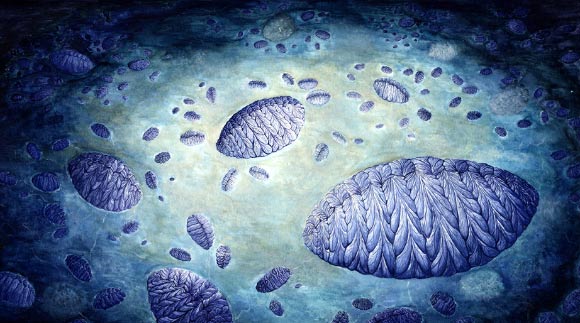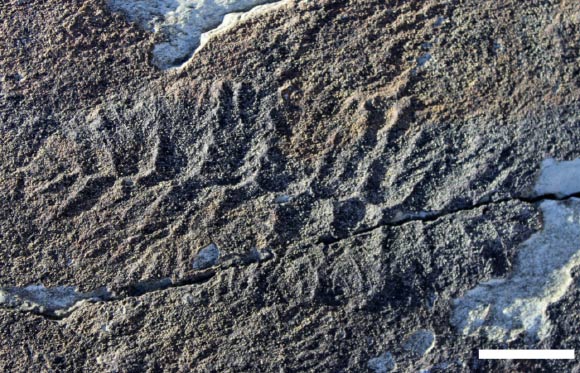A new study has found that Ediacaran organisms known as rangeomorphs reproduced by taking a joint approach: they first sent out an ‘advance party’ to settle in a new area, followed by rapid colonization of the new neighborhood.

Artist’s reconstruction of the Fractofusus community: the bottom right features a large Fractofusus around which there are 5 to 8 medium specimens clustered; each of the medium specimens also has small specimens clustered around them; the small specimens therefore form an independent double cluster pattern, namely clusters of clusters. Image credit: C.G. Kenchington.
Rangeomorphs were some of the earliest complex organisms on Earth, and have been considered to be some of the first animals – although it’s difficult for scientists to be entirely sure.
They thrived in the oceans during the Ediacaran period, between 580 and 541 million years ago, and could reach up to 6.5 feet (2 m) in length, although most were around 4 inches (10 cm).
Looking like trees or ferns, they did not appear to have mouths, organs, or means of moving, and probably absorbed nutrients from the water around them.
Like many of the life forms during the Ediacaran, rangeomorphs mysteriously disappeared at the start of the Cambrian period, which began about 540 million years ago, so it has been difficult to link rangeomorphs to any modern organisms, or to figure out how they lived, what they ate and how they reproduced.
“Rangeomorphs don’t look like anything else in the fossil record, which is why they’re such a mystery. But we’ve developed a whole new way of looking at them, which has helped us understand them a lot better – most interestingly, how they reproduced,” said Dr Emily Mitchell from the University of Cambridge, UK, who is the lead author of a paper published in the journal Nature.

Fractofusus andersoni specimen from Newfoundland, Canada. Scale bar – 1 cm. Image credit: Emily G. Mitchell et al.
Using statistical techniques to assess the distribution of populations of a rangeomorph called Fractofusus, Dr Mitchell and co-authors observed that larger ‘grandparent’ rangeomorphs were randomly distributed in their environment, and were surrounded by distinct patterns of smaller ‘parents’ and ‘children.’
These patterns strongly resemble the biological clustering observed in modern plants, and suggest a dual mode of reproduction: the ‘grandparents’ being the product of ejected waterborne propagules, while the ‘parents’ and ‘children’ grew from ‘runners’ sent out by the older generation, like strawberry plants.
“Reproduction in this way made rangeomorphs highly successful, since they could both colonize new areas and rapidly spread once they got there,” Dr Mitchell said.
“The capacity of these organisms to switch between two distinct modes of reproduction shows just how sophisticated their underlying biology was, which is remarkable at a point in time when most other forms of life were incredibly simple.”
_____
Emily G. Mitchell et al. Reconstructing the reproductive mode of an Ediacaran macro-organism. Nature, published online August 03, 2015; doi: 10.1038/nature14646







